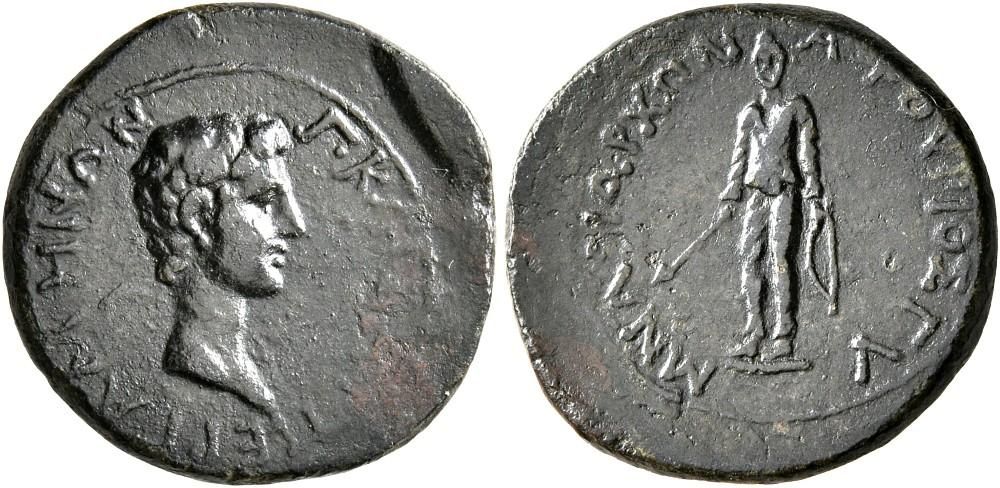Augustus 27 BC-14 AD - AE Hemiassarion - RPC-I-2361
Reference Description
Augustus 27 BC-14 AD / Gaius Caesar
AE Hemiassarion, 2-3 AD, Pergamum, Mysia
Obv. Γ KAICAP ΠEPΓAMHNΩN
Bare head of Gaius Caesar to right.
Rev. A ΦOYPIOΣ ΓYMNAΣIAPXΩN
Armenian standing facing, wearing bashlyk and long garnments, holding spear downward in his right hand and bow in his left.
RPC-I-2361
SNG Paris 2031
AE Hemiassarion, 2-3 AD, Pergamum, Mysia
Obv. Γ KAICAP ΠEPΓAMHNΩN
Bare head of Gaius Caesar to right.
Rev. A ΦOYPIOΣ ΓYMNAΣIAPXΩN
Armenian standing facing, wearing bashlyk and long garnments, holding spear downward in his right hand and bow in his left.
RPC-I-2361
SNG Paris 2031
Recent Sales
Leu Numismatik Auction 5 Lot 262 (26-Oct-2019) Realized CHF 3,600
(Bronze, 18mm, 3.14g, 12h)
Leu Numismatik Web Auction 27 Lot 1176 (9-Sep-2023) Realized CHF
(Bronze, 16mm, 2.75g, 12h)
(Bronze, 18mm, 3.14g, 12h)
Leu Numismatik Web Auction 27 Lot 1176 (9-Sep-2023) Realized CHF
(Bronze, 16mm, 2.75g, 12h)
Notes
Leu Numismatik Web Auction 27 Lot 1176
The reverse of this very rare issue refers to the Parthian campaign of Gaius Caesar, who installed Ariobarzanes, the former king of Media Atropatene, as king of Armenia in 2 AD after Tigranes IV had died in battle the year before. However, Ariobarzanes died soon thereafter and Gaius faced an Armenian revolt incited by the Parthian king, Phraates V. The Romans trapped the rebels in Artagira, but Gaius was severely wounded after Abbadon, the leader of the uprising, treacherously invited him into the fortress for pretended peace talks on 9 September 3 AD. In the end, Roman military might prevailed nonetheless and Gaius installed Ariobarzanes' son, Artavasdes IV, as the new king of Armenia. Augustus' victorious grandson, however, died a few months later in Limyra in Lycia from complications caused by his wounds.
The reverse of this very rare coin from Pergamum, which celebrates Gaius' success, was largely copied from Augustus' earlier denarius celebrating Tiberius' achievements in Armenia in 20 BC (RIC 519), when the future emperor had installed Tigranes III as king. The asiarch, A. Fourios, is dated in RPC to 1 BC (?), but this is an error as the Armenian campaign of Gaius did not take place in 2 BC, as noted on RPC I, p. 401, but in 2-3 AD, meaning that his coin emission was struck either in 2 AD to celebrate the appointment of Ariobarzanes as king of Armenia, or in the year thereafter, following the capture of Artagira and the installment of Artavasdes IV. While the obverse is sometimes described as showing Augustus, the legend leaves no doubt that it is in fact Gaius Caesar: it is the only known coin where he appears without his grandfather or his younger brother Lucius, no doubt in reference to the key role he played in the course of the Armenian victory celebrated on the reverse.
The reverse of this very rare issue refers to the Parthian campaign of Gaius Caesar, who installed Ariobarzanes, the former king of Media Atropatene, as king of Armenia in 2 AD after Tigranes IV had died in battle the year before. However, Ariobarzanes died soon thereafter and Gaius faced an Armenian revolt incited by the Parthian king, Phraates V. The Romans trapped the rebels in Artagira, but Gaius was severely wounded after Abbadon, the leader of the uprising, treacherously invited him into the fortress for pretended peace talks on 9 September 3 AD. In the end, Roman military might prevailed nonetheless and Gaius installed Ariobarzanes' son, Artavasdes IV, as the new king of Armenia. Augustus' victorious grandson, however, died a few months later in Limyra in Lycia from complications caused by his wounds.
The reverse of this very rare coin from Pergamum, which celebrates Gaius' success, was largely copied from Augustus' earlier denarius celebrating Tiberius' achievements in Armenia in 20 BC (RIC 519), when the future emperor had installed Tigranes III as king. The asiarch, A. Fourios, is dated in RPC to 1 BC (?), but this is an error as the Armenian campaign of Gaius did not take place in 2 BC, as noted on RPC I, p. 401, but in 2-3 AD, meaning that his coin emission was struck either in 2 AD to celebrate the appointment of Ariobarzanes as king of Armenia, or in the year thereafter, following the capture of Artagira and the installment of Artavasdes IV. While the obverse is sometimes described as showing Augustus, the legend leaves no doubt that it is in fact Gaius Caesar: it is the only known coin where he appears without his grandfather or his younger brother Lucius, no doubt in reference to the key role he played in the course of the Armenian victory celebrated on the reverse.
Collection
Citation
“Augustus 27 BC-14 AD - AE Hemiassarion - RPC-I-2361,” Armenian Numismatic Research Organization, accessed January 22, 2025, https://armnumres.org/items/show/1116.


